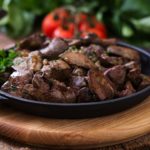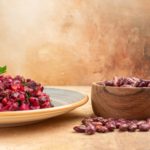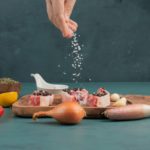
Tiana Hape-Cramond
(Associate Registered Nutritionist)
Jump to:
Iron is an essential mineral that plays a pivotal role in our everyday existence, and is important for:
- Pregnancy and foetal development
- Oxygen transport
- Energy production
- Brain health
- Immune support
- Temperature regulation
Iron can be found in both vegetables and animal products or supplementation.
In this article we explore iron, its function in the body, iron deficiency and more.
What is Iron?
Iron is essential for the production of red blood cells. Approximately 70% of the body’s iron is found in the red blood cells in the form of haemoglobin, and in the muscle as myoglobin.
Haemoglobin is essential for transferring oxygen from the lungs to the tissues and myoglobin accepts, stores, transports and releases oxygen.[1]
Healthy infants are born with sufficient iron stores and can survive for 6 months before depleting their stores. The average human body has 3.5 grams of iron, 70% of which is haemoglobin.[2]
History behind Iron
Iron has been used by physicians to treat a variety of illnesses throughout history. In the 16th century iron was used to treat some disorders such as alopecia, tuberculosis, acne, gout, edema, fevers and more.
Nicolas Lemery and Étienne François Geoffory are credited with demonstrating the presence of iron in 1713 but almost 2 centuries passed before metabolism of iron in the body was beginning to be understood.[3]
Reliable testing for blood haemoglobin was not created until 1875 and took years before it was widely accepted.[2]
Iron deficiency
Iron deficiency is one of the most common dietary deficiency globally. Factors that can cause inadequate iron levels are:
- blood loss
- insufficient iron in the diet
- poor absorption of dietary iron in the digestive tract
- pregnancy[4]
A study suggested that in New Zealand approximately 10% of women and 1% of men have iron deficiency.[5]

Who is most at risk of iron deficiency?
Menstruating women
Teenage girls and women who have experienced heavy periods are at higher risk of developing iron deficiency as they are losing blood during their monthly periods.[6]
Pregnant women
Pregnant women are at higher risk of iron deficiency as they require twice the amount of iron. The increase in the need for iron is due to increased blood volume and for foetus growth.[6]
Infants
Infants, especially premature or low-birth weight, require iron to grow and develop properly. The iron that a full-term infant uses for the first 4 to 6 months of life is from the stores developed during foetal development.
Infants that are premature or have low birth weights are at greater risk of iron deficiency as they do not have as much stored iron in their bodies.[6]
Individuals receiving dialysis
People receiving dialysis treatment may develop iron deficiency. This is due to the blood that is lost during dialysis and the kidneys no longer being able to produce erythropoietin which helps produce red blood cells.[6]
Gastric bypass
Individuals with a gastric bypass are at a greater risk of iron deficiency. This is due to the body being unable to absorb enough iron through diet.[6]
Individuals with certain dietary patterns
People who follow vegetarian or vegan diets are at higher risk of iron deficiency because of the elimination of heme iron-rich foods such as meat.
Those who follow high-fibre diets can also increase the risk of developing iron deficiency as large amounts of fibre can slow the absorption of iron.[6]
Different types of Iron
Heme Iron
Heme iron is found in animal based foods and is more easily absorbed. It’s predominantly in the blood and muscle (red meat and organs) but can be found in other sources such as mussels, oysters and clams and plant-based products derived from soy (e.g. Impossible Burgers).[7]
Non-heme Iron
Non-heme iron is iron found in plants. As it is less bioavailable compared to haem iron, it can be influenced by dietary factors.
Consuming vitamin C rich foods can enhance iron absorption
However, compounds such as phytates (found in wholegrains and legumes) and polyphenols (found in tea and coffee) can inhibit non-heme iron absorption.[8]
Ferrous sulfate
Ferrous sulfate is an iron salt that is well absorbed in the body. This form of supplement provides a source of elemental iron that the body can use to replenish the body’s iron stores and support synthesis of new red blood cells.[9]
Ferrous sulfate is the most common prescribed iron supplement
Ferrous gluconate
Ferrous gluconate is a type of iron supplement that is used to treat or prevent iron-deficiency anaemia. Ferrous gluconate is a form of iron that is also easily absorbed in the body. It is available in tablets, capsules and liquid forms.[10]
Ferrous fumarate
Ferrous fumarate is a combination of iron and fumaric acid. It is best taken on an empty stomach, ideally one hour before eating or 2 hours after eating. It is available as tablets, capsules or liquid.[11]
Type of Supplement | Amount of elemental iron per tablet |
Ferrous Sulfate | 325 mg tablet (contains 65 mg elemental iron per tablet – hydrated. Contains 120 mg elemental iron in desiccated form) |
Ferrous Fumarate | 324 or 325 mg tablet (contains 106 mg elemental iron per tablet) |
Ferrous Gluconate | 324 mg tablet (contains 38 mg elemental iron per tablet) |
Iron with a greater amount of elemental iron means more iron will be available to absorb.[12]
Health benefits of Iron
Iron has many functions which contribute to health benefits such as aiding in the formation of haemoglobin and cell production.
Pregnancy and foetal development
Maternal-iron status has been linked to some neurological disorders and mental health disorders in their offspring.
Low iron levels in the second trimester of pregnancy can increase the risk of the child developing schizophrenia by 30% and infants born with low serum ferritin concentrations have poorer recognition at birth.[13]

Source: Harvey, T. Assessment of Iron Deficiency and Anemia in Pregnant Women: An Observational French Study. (2016)
As maternal haemoglobin decreased the number of offspring with schizophrenia spectrum disorder increased.[14]
Oxygen transport
The main function of iron is the formation of haemoglobin, which is the protein in red blood cells that carries oxygen from the lungs to other parts of the body.[15]
A decreased saturation of haemoglobin in the blood leads to a decreased levels of oxygen in the blood.[16]
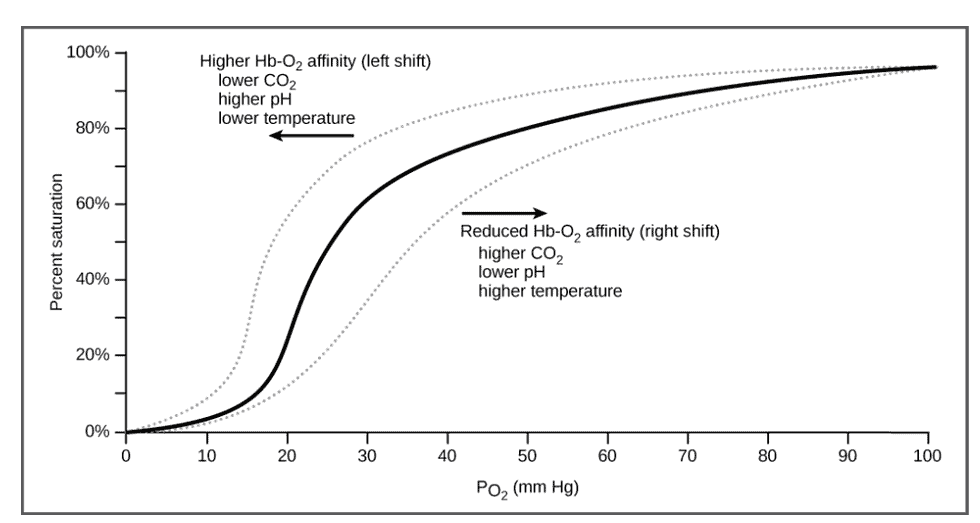
Energy production
Iron is a component of myoglobin, a protein found in muscle cells that stores and transports oxygen from muscle contractions. This is important for maintaining energy levels and physical performance.
It is seen in non-anemic male athletes that a low dose of iron supplementation can improve the symptoms of tiredness after exercise and provides relief from fatigue.[17]
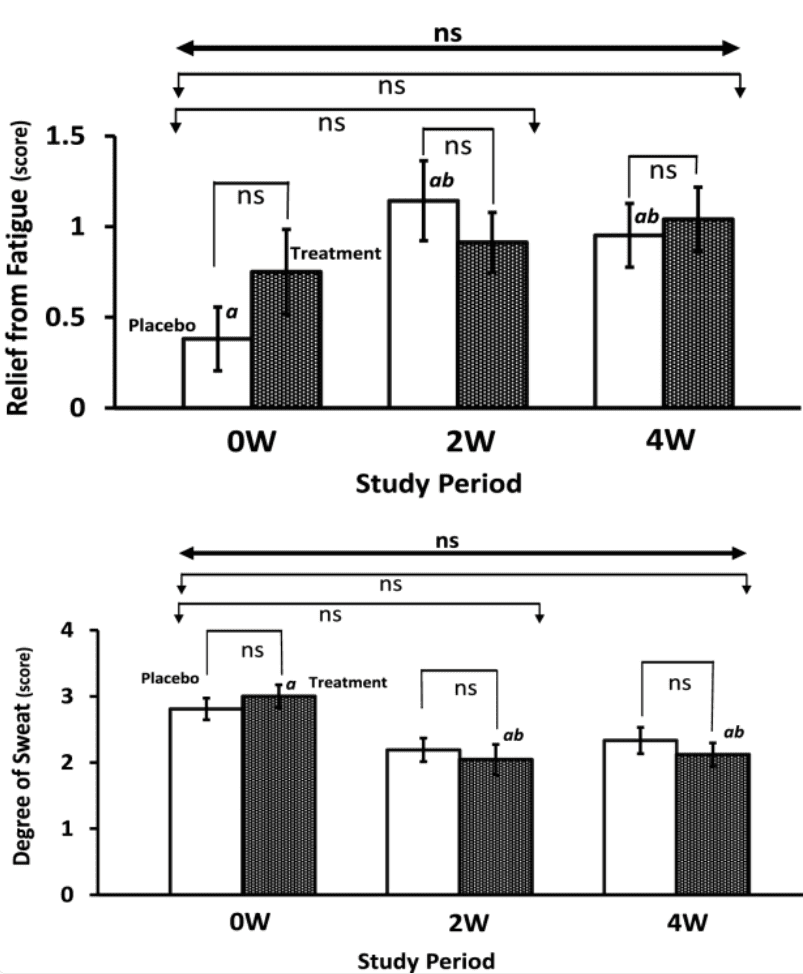
Brain health
Iron is important for brain function as it plays important roles in:
- neurotransmitter homeostasis
- myelin production
- basal ganglia function[18]
It was found that if iron deficiency is present in the first two years of life it is associated with poor psychomotor performance, decreased response to stimuli and irritability.[19]
Immune system support
Iron is important for supporting the immune system, immune cell reproduction and maturation associated with the generation of specific response to infections.[20]
Research has found that low amounts of iron in the blood can inhibit immune responses to vaccines as t-lymphocytes require iron to support their metabolism. T-lymphocytes are important for destroying infected cells and helping antibody responses to infections.[21]
Temperature regulation
Iron plays a crucial role in temperature regulation due to its involvement in transporting oxygen and maintaining cellular respiration and energy production which influences body temperature.
Iron-deficient individuals have an impaired response to cold temperature with rapid cooling body core temperature.[22]
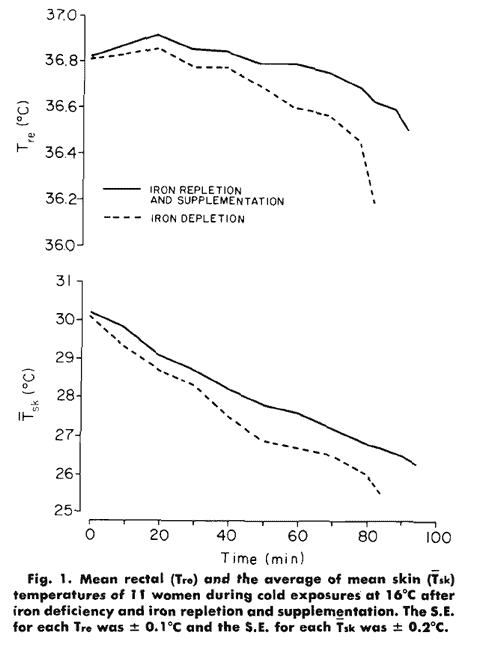
DNA synthesis
Iron plays an important role in the synthesis of DNA. Iron is involved in several biological processes. Iron acts as a redox element that functions as a cofactor in metabolic pathways including DNA metabolism, DNA repair enzymes and ribonucleotide reductase.[23]
Healthy skin, hair and nails
Iron is involved in oxygen metabolism and mitochondrial function which is important for normal growth and functional maturation of the skin and healthy hair and nails.[24]
In individuals with iron deficiency hair may become dry or fall out and nails may break more easily or change shape.[25]
Health claims that still need more evidence and research
Menstruation relief
Women with low iron could have lower haemoglobin and ferritin which can cause symptoms such as nausea, vomiting or tiredness during pre-menstruation.[26]
Research found that anaemia, production of lower–than-normal red blood cells, may be associated with dysmenorrhoea.
Dysmenorrhoea is described as painful cramps and can be accompanied by dizziness, cold sweating, and sometimes fainting.[27]
Taking an iron supplement may be able to alleviate some of the symptoms such as dizziness and prevent fainting.
Iron deficiency and depression
The correlation between poor nutrition and depression has been explored before and the association between low levels of haemoglobin and low ferritin plasma levels in women with postpartum depression has been found.[28]
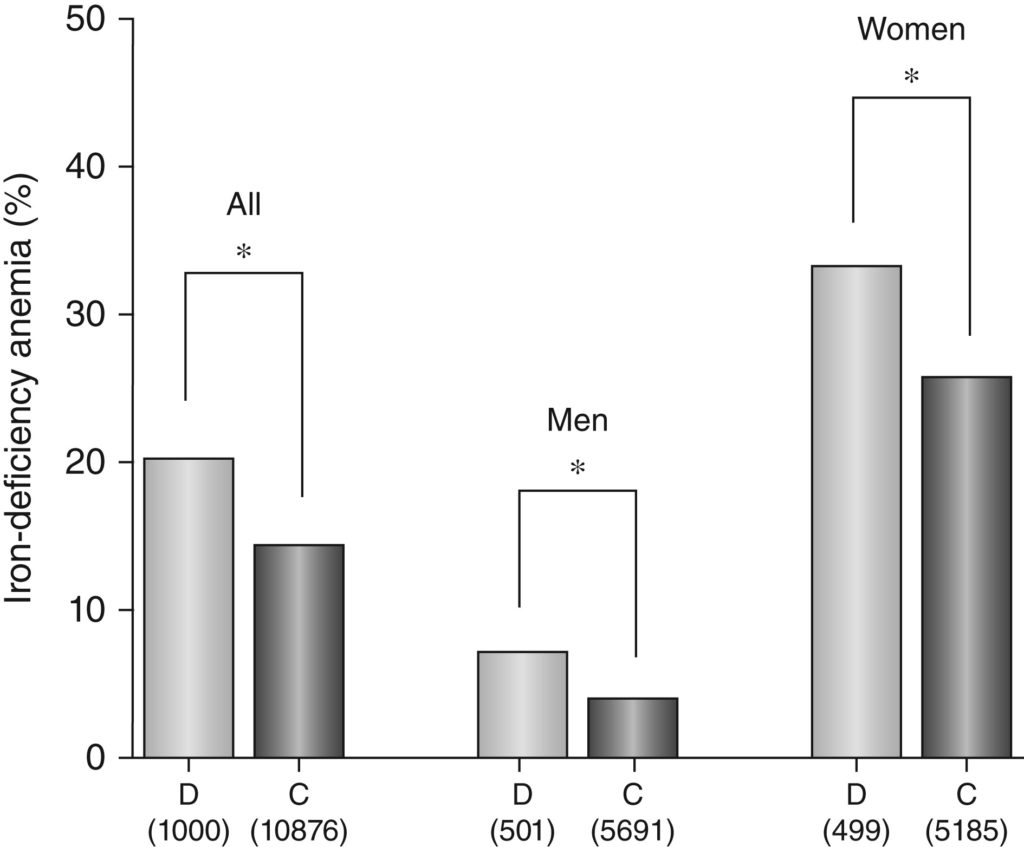
RELATED — Introduction to: Depression
The figure above shows more individuals with self-reported iron-deficiency anaemia scored 13 or more on the Kessler scale when compared to the control group of non-anaemic individuals.[29]
Best sources of Iron
Food Source | Concentration (mg/100g) | Daily Value (DV) Men / Women |
Green Mussels | 5.7 mg | 71% / 32% |
Tofu | 5.4 mg | 67% / 30% |
Chickpeas | 2.8 mg | 35% / 15% |
Fortified Cereal | 2.7 mg | 33% / 15% |
Beef fillet steak | 2.6 mg | 32% / 14% |
Spinach | 2.5 mg | 31% / 13% |
Chicken breast | 2.0 mg | 25% / 11% |
Baked beans | 2.0 mg | 25% / 11% |
Lamb steaks | 1.9 mg | 23% / 10% |
Pork chops | 0.9 mg | 11% / 5% |
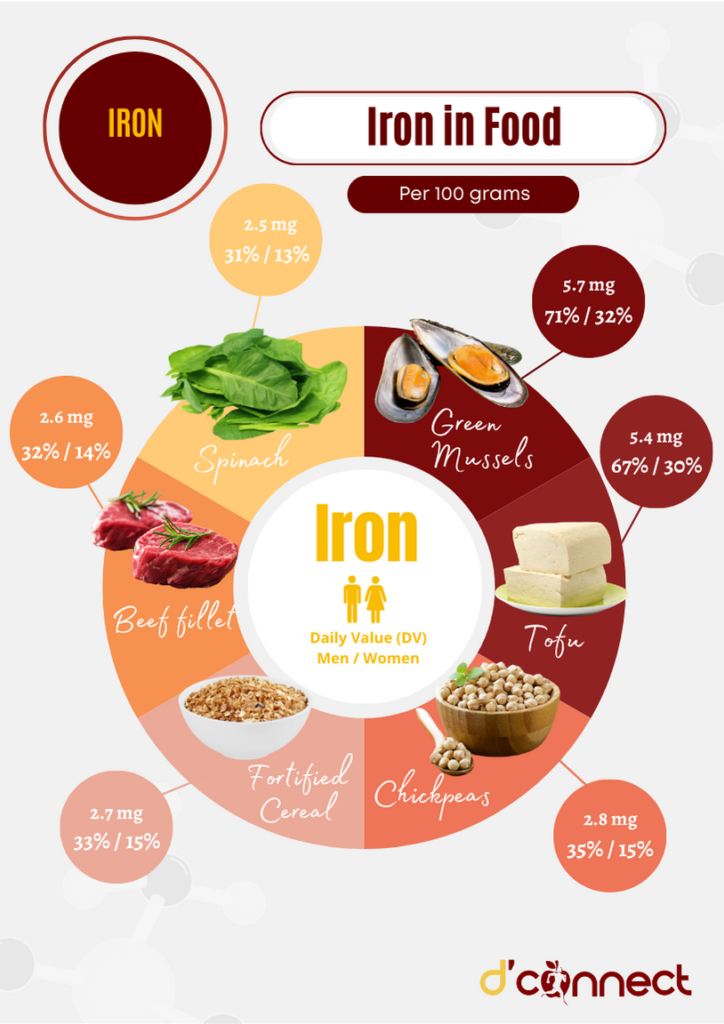
Important note — if you’re enjoying a daily mix of meat and vegetables, you should easily meet your iron demands.
Daily requirements and recommended Intake
The recommended daily intake (RDI) of iron changes throughout the lifespan. Babies, children and teenagers require more iron as they are rapidly growing. Women who experience periods require more iron due to the loss of blood each month.[30]
Age | Male (RDI) | Female (RDI) |
7-12 months | 11 mg/day | 11 mg/day |
1-3 years | 9 mg/day | 9 mg/day |
4-8 years | 10 mg/day | 10 mg/day |
9-13 years | 8 mg/day | 8 mg/day |
14-18 years | 11 mg/day | 15 mg/day |
19-50 years | 8 mg/day | 18 mg/day |
50+ years | 8 mg/day | 8 mg/day |
For pregnancy and lactation, the amount increases to 27 mg and 10 mg, respectively.
How to take Iron as a supplement
Iron can be given orally or intravenously. Oral supplements are the most common and easily accessible.
Iron infusions provide quicker improvements of iron-deficiency symptoms. Reasons for iron infusions include:
- individual can not tolerate iron taken orally
- gut has issues absorbing iron (e.g. in people with inflammatory bowel disease)
- blood loss makes it difficult to keep iron (e.g. after a severe injury)
- to increase iron levels quickly
- long term health issues which prevent the body using iron (e.g. rheumatoid arthritis or some types of cancer)
- chronic kidney problems or heart failure[31]
Iron supplements should be taken on an empty stomach
This should be either 1 hour before or 2 hours after eating, with a drink containing vitamin C.
However, to lessen the possibility of stomach issues, iron may be taken with or immediately after food.[32]
Common signs and symptoms of Iron deficiency
Iron is important for good health. The symptoms of iron deficiency include:
- Weakness
- Lack of concentration
- Irritability
- Fatigue
- Shortness of breath
- Pale skin
- Dizziness
- Heart palpitations
- Headaches
- Hair loss
- Dry skin[25]
If you are experiencing any of the symptoms listed above please seek medical advice.
Iron risks and side effects
Iron can be found in many over-the-counter supplements. This availability means that iron toxicity can be common.
Iron toxicity can also develop after several blood transfusions for chronic disorders such as thalassemia, sickle cell or haematological cancers.[33]
Acute ingestion of iron can be hazardous to children but if adult dosages of iron are ingested, it can be life-threatening.
Ingesting too much iron can cause severe symptoms, liver damage and death. Symptoms include gastrointestinal upset (vomiting, diarrhoea and abdominal pain), while liver failure can develop days later.[34]
Common side effects from iron supplements include:
- Dark or black coloured stool
- Nausea
- Constipation
- Diarrhoea
Often these side effects improve as your body becomes accustomed to the supplement.[35]
Possible interactions with herbs and supplements
Supplements containing aluminium (some antacids), calcium, magnesium or zinc may reduce their intended purpose when taken at the same time as iron supplements.
It is best to not take these within 2 hours of taking iron supplements.[36]
Possible interactions with medications
Taking an iron supplement may interact with other medications such as:
- Tetracycline
- Penicillin
- Ciprofloxacin
- Medications used to treat Parkinson’s Disease and seizures (for example phenytoin)
Medications that reduce stomach acid such as antacids impair iron absorption and may cause iron deficiency.[37]
Thyroid medications such as levothyroxine should be taken separately to iron supplements, since iron can interfere with the absorption of thyroid medication in the gut.[38]
Discuss with a medical professional if taking iron supplements is right for you.
Summary
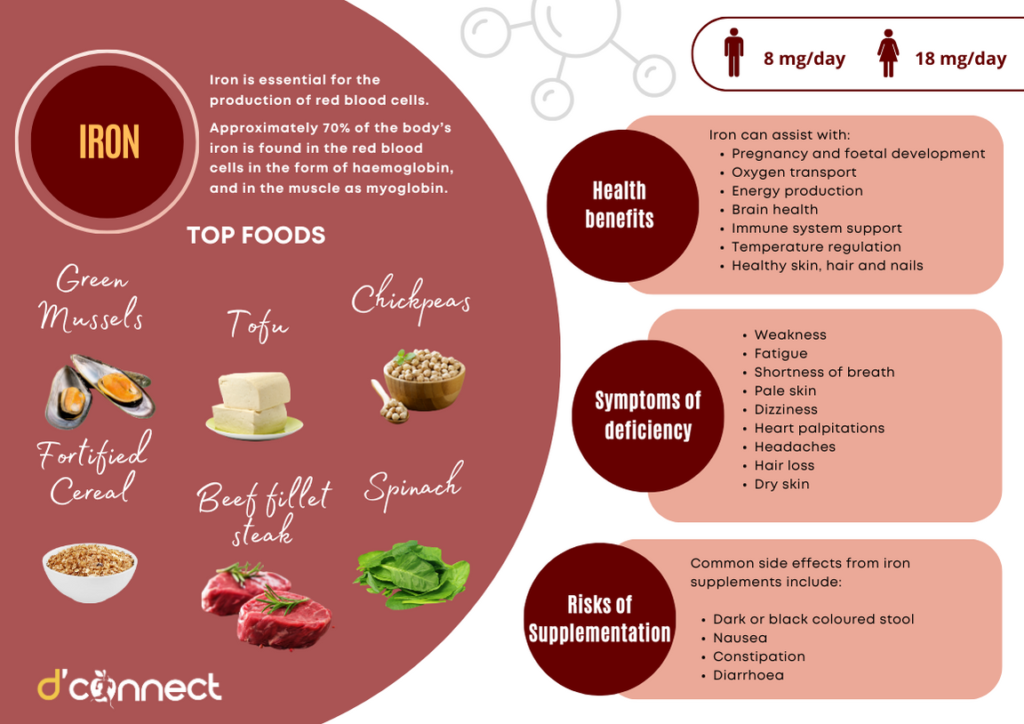
Key Takeaway — In this illustration we have outlined the most important information that you should know about Iron.
Related Questions
1. How can I raise my iron quickly?
Iron levels will increase as you begin to add more iron-rich sources into your diet. This can be done through foods, fortified foods such as cereals or supplementation.[39]
2. Does low iron cause weight gain?
Low iron may cause weight gain as energy levels will be low which can decrease your motivation for exercise and healthy eating.
Another way could be due to the low iron affecting thyroid function which can stimulate weight gain.[40]
3. Which vegetables are high in iron?
Iron-rich vegetables include:
- Broccoli
- Beans
- Brussel sprouts
- Kale.[41]
4. Can our body accumulate too much iron by eating too much meat?
Iron overload is when the body accumulates too much iron which is usually caused by the body’s regulatory system failing to keep iron at a healthy level.
Iron overload in healthy individuals is rare. However, it can occur in individuals that suffer from excess absorption of iron in the gut such as hemochromatosis.[42]
5. How long does it take for the body to adjust to taking iron in a supplement form?
Usually it can take up to 2 to 3 weeks of regularly taking iron supplements before symptoms improve.[43]
If you have any comments or questions, please let us know below. You can find more similar articles in our Nutrition section.
Tiana is an Associate Registered Nutritionist who has a passion for public health and education. Working towards a Master’s in Nutrition Practice with a Bachelor’s in Human Nutrition, Tiana has a personal interest in healthy heart nutrition and promoting positive lifestyle behaviours.
Tiana is a part of the Content Team that brings you the latest research at D’Connect.
References
(1) UCSF Health. Hemoglobin and Functions of Iron [Internet]. ucsfhealth.org. UCSF Health; 2019 [cited 2023 Sep 13]. Available from: https://www.ucsfhealth.org/education/hemoglobin-and-functions-of-iron
(2) Wick JY. Mudpies and Magpies: Iron at the Extremes: Iron. What associations come to mind? Animal, vegetable, mineral? Prime rib, Popeye’s spinach, or your grandmother’s cast iron griddle? Is one source of this micronutrient better than another? New approaches to old problems are giving iron a facelift. Journal of the American Pharmacists Association. 2003 Sep 1;43(5):556-60.
(3) Beutler E. History of iron in medicine. Blood Cells Mol Dis. 2002 Nov-Dec;29(3):297-308. doi: 10.1006/bcmd.2002.0560. PMID: 12547220.
(4) Iron deficiency anaemia – symptoms, causes and treatment [Internet]. Southerncross.co.nz. 2022 [cited 2023 Jul 29]. Available from: https://www.southerncross.co.nz/medical-library/blood-and-blood-vessel-conditions/iron-deficiency-anaemia-symptoms-causes-and-treatment
(5) University of Otago and Ministry of Health (2011). A Focus on Nutrition: Key findings of the 2008/09 New Zealand Adult Nutrition Survey. Wellington: New Zealand Ministry of Health. 2011. Available from: https://www.health.govt.nz/publication/focus-nutrition-key-findings-2008-09-nz-adult-nutrition-survey.
(6) Who is at Risk of Iron-Deficiency Anemia? [Internet]. Hematology-Oncology Associates of CNY. 2023 [cited 2023 Jul 29]. Available from: https://www.hoacny.com/patient-resources/blood-disorders/what-iron-deficiency-anemia/who-risk-iron-deficiency-anemia
(7) O’Brien C. Heme and Non Heme Iron Foods & Sources – Active Iron [Internet]. Active Iron. 2020 [cited 2023 Oct 5]. Available from: https://www.activeiron.com/blog/everything-you-need-to-know-about-heme-iron/
(8) Iron [Internet]. The Nutrition Source. 2019 [cited 2023 Sep 25]. Available from: https://www.hsph.harvard.edu/nutritionsource/iron/#:~:text=Heme%20is%20found%20only%20in,heme%20iron)%20and%20fortified%20foods.
(9) NHS Choices. Ferrous sulfate – Brand name: Ironorm Drops [Internet]. 2023 [cited 2023 Sep 25]. Available from: https://www.nhs.uk/medicines/ferrous-sulfate/
(10) PubChem. Ferrous Gluconate [Internet]. @pubchem. PubChem; 2023 [cited 2023 Oct 9]. Available from: https://pubchem.ncbi.nlm.nih.gov/compound/Ferrous-Gluconate
(11) NHS Choices. About ferrous fumarate – Brand names: Fersamal, Galfer [Internet]. 2023 [cited 2023 Sep 20]. Available from: https://www.nhs.uk/medicines/ferrous-fumarate/about-ferrous-fumarate/
(12) LiverTox: Clinical and Research Information on Drug-Induced Liver Injury [Internet]. Bethesda (MD): National Institute of Diabetes and Digestive and Kidney Diseases; 2012-. [Table, Concentrations of elemental iron in typical iron tablets] Available from: https://www.ncbi.nlm.nih.gov/books/NBK548214/table/Iron.T1/
(13) Georgieff M. Iron deficiency in pregnancy. American Journal of Obstetrics and Gynecology [Internet]. 2020 Oct 1 [cited 2023 Sep 21];223(4):516–24. Available from: https://www.ncbi.nlm.nih.gov/pmc/articles/PMC7492370/#:~:text=Maternal%2Dfetal%20iron%20status%20has,of%20autism%20in%20the%20offspring.
(14) Insel BJ, Schaefer C, McKeague IW, Süsser E, Brown AS. Maternal Iron Deficiency and the Risk of Schizophrenia in Offspring. Archives of General Psychiatry [Internet]. 2008 Oct 6 [cited 2023 Oct 5];65(10):1136–6. Available from: https://www.ncbi.nlm.nih.gov/pmc/articles/PMC3656467/
(15) Marengo-Rowe AJ. Structure-Function Relations of Human Hemoglobins. Baylor University Medical Center Proceedings [Internet]. 2006 Jul 1 [cited 2023 Oct 15];19(3):239–45. Available from: https://www.ncbi.nlm.nih.gov/pmc/articles/PMC1484532/#:~:text=Hemoglobin%20is%20a%20two%2Dway,and%20hydrogen%20and%20chloride%20ions.
(16) Transport of Oxygen in the Blood | Biology for Majors II [Internet]. Lumenlearning.com. 2023 [cited 2023 Oct 8]. Available from: https://courses.lumenlearning.com/wm-biology2/chapter/transport-of-oxygen-in-the-blood/
(17) Kapoor MP, Sugita M, Kawaguchi M, Timm DH, Kawamura A, Abe A, et al. Influence of iron supplementation on fatigue, mood states and sweating profiles of healthy non-anemic athletes during a training exercise: A double-blind, randomized, placebo-controlled, parallel-group study. Contemporary clinical trials communications [Internet]. 2023 Apr 1 [cited 2023 Sep 25];32:101084–4. Available from: https://www.ncbi.nlm.nih.gov/pmc/articles/PMC9932653/#:~:text=Iron%20is%20necessary%20for%20oxygen,breath%2C%20and%20exhaustion%20during%20exercise.
(18) Lyudmila Pivina, Yuliya Semenova, Monica Daniela Doşa, Marzhan Dauletyarova, Geir Bjørklund. Iron Deficiency, Cognitive Functions, and Neurobehavioral Disorders in Children. Journal of Molecular Neuroscience [Internet]. 2019 Feb 18 [cited 2023 Sep 16];68(1):1–10. Available from: https://link.springer.com/article/10.1007/s12031-019-01276-1#:~:text=Iron%20is%20an%20essential%20element,cognitive%20functions%20and%20psychomotor%20development.
(19) Jáuregui-Lobera I. Iron deficiency and cognitive functions. Neuropsychiatric Disease and Treatment [Internet]. 2014 Nov 1 [cited 2023 Sep 21];2087–7. Available from: https://www.ncbi.nlm.nih.gov/pmc/articles/PMC4235202/
(20) Soyano A, Gómez M. Participación del hierro en la inmunidad y su relación con las infecciones [Role of iron in immunity and its relation with infections]. Arch Latinoam Nutr. 1999 Sep;49(3 Suppl 2):40S-46S. Spanish. PMID: 10971835.
(21) Frost F, Tiong Kit Tan, Abbas M, Wideman S, Bonadonna M, Stoffel NU, et al. Hepcidin-Mediated Hypoferremia Disrupts Immune Responses to Vaccination and Infection. Med [Internet]. 2021 Feb 1 [cited 2023 Sep 11];2(2):164-179.e12. Available from: https://www.cell.com/med
(22) Lukaski H, Hall CB, Nielsen FH. Thermogenesis and thermoregulatory function of iron-deficient women without anemia [Internet]. ResearchGate. Aerospace Medical Association; 1990 [cited 2023 Sep 21]. Available from: https://www.researchgate.net/publication/20913804_Thermogenesis_and_thermoregulatory_function_of_iron-deficient_women_without_anemia
(23) Puig S, Ramos-Alonso L, Romero AM, Martínez-Pastor MT. The elemental role of iron in DNA synthesis and repair. Metallomics. 2017 Nov 15;9(11):1483-1500. doi: 10.1039/c7mt00116a. PMID: 28879348.
(24) Lansdown G. Iron: a cosmetic constituent but an essential nutrient for healthy skin. International Journal of Cosmetic Science [Internet]. 2001 Jun 1 [cited 2023 Sep 20];23(3):129–37. Available from: https://onlinelibrary.wiley.com/doi/pdf/10.1046/j.1467-2494.2001.00082.x
(25) Health Info. Low iron & iron deficiency anaemia. Te Whatu Ora. 2023. Available from: https://www.healthinfo.org.nz/patientinfo/649135.pdf
(26) Kohli S. Science says eating foods rich in this nutrient can reduce your period cramps [Internet]. Healthshots; 2020 [cited 2023 Sep 21]. Available from: https://www.healthshots.com/intimate-health/menstruation/eating-foods-rich-in-iron-can-reduce-your-period-pain/
(27) Kusumawardani PA. The relations between anemia and female adolescent’s dysmenorrhea. In 4th UPHEC (Universitas Ahmad Dahlan International Conference on Public Health) 2018 Feb 21 (Vol. 1, No. 1, pp. 200-205). Universitas Ahmad Dahlan.
(28) Hameed S, Naser IA, Mohamed, Ellulu MS. Is iron deficiency a risk factor for postpartum depression? A case–control study in the Gaza Strip, Palestine. Public Health Nutrition [Internet]. 2021 Aug 31 [cited 2023 Oct 9];25(6):1631–8. Available from: https://www.ncbi.nlm.nih.gov/pmc/articles/PMC9991634/#:~:text=In%20the%20current%20study%2C%20the,level%20of%20the%20postpartum%20mothers.
(29) Shinsuke Hidese, Saito K, Asano S, Hiroshi Kunugi. Association between iron-deficiency anemia and depression: A web-based Japanese investigation. Psychiatry and Clinical Neurosciences [Internet]. 2018 May 9 [cited 2023 Oct 8];72(7):513–21. Available from: https://onlinelibrary.wiley.com/doi/full/10.1111/pcn.12656
(30) Iron – NZ Nutrition Foundation [Internet]. NZ Nutrition Foundation. 2023 [cited 2023 Oct 9]. Available from: https://nutritionfoundation.org.nz/nutrition-facts/nutrients/minerals/iron/
(31) Iron Infusion – IV Iron Treatment – Auckland Iron Clinic – NZ [Internet]. Auckland Iron Clinic. 2019 [cited 2023 Oct 9]. Available from: https://www.aucklandironclinic.co.nz/iron-infusion/
(32) The Blood Safety and Conservation Team. Taking Iron Supplements Information for patients [Internet]. 2015 Jun. Available from: https://www.ouh.nhs.uk/patient-guide/leaflets/files/11903Piron.pdf
(33) Yuen HW, Becker W. Iron Toxicity [Internet]. Nih.gov. StatPearls Publishing; 2023 [cited 2023 Sep 13]. Available from: https://www.ncbi.nlm.nih.gov/books/NBK459224/
(34) O’Malley GF, Rika O’Malley. Iron Poisoning [Internet]. MSD Manual Consumer Version. MSD Manuals; 2022 [cited 2023 Sep 13]. Available from: https://www.msdmanuals.com/en-nz/home/injuries-and-poisoning/poisoning/iron-poisoning#:~:text=Iron%20is%20a%20mineral%20essential,failure%20can%20develop%20days%20later.
(35) Iron supplements (oral) | Healthify [Internet]. Healthify. 2023 [cited 2023 Sep 13]. Available from: https://healthify.nz/medicines-a-z/i/iron-supplements-oral/
(36) NHS Choices. Taking ferrous fumarate with other medicines and herbal supplements – Brand names: Fersamal, Galfer [Internet]. 2023 [cited 2023 Sep 16]. Available from: https://www.nhs.uk/medicines/ferrous-fumarate/taking-ferrous-fumarate-with-other-medicines-and-herbal-supplements/#:~:text=Mixing%20ferrous%20fumarate%20with%20herbal%20remedies%20or%20supplements&text=Tell%20a%20pharmacist%20or%20doctor%20if%20you%20take%20any%20supplements,the%20effect%20of%20ferrous%20fumarate.
(37) Taking iron supplements: MedlinePlus Medical Encyclopedia [Internet]. Medlineplus.gov. 2018 [cited 2023 Sep 16]. Available from: https://medlineplus.gov/ency/article/007478.htm#:~:text=Iron%20tablets%20may%20cause%20other,and%20may%20cause%20iron%20deficiency.
(38) Walker J. Iron Deficiency and Thyroid Disease [Internet]. Palomahealth.com. Paloma Health; 2022 [cited 2023 Sep 25]. Available from: https://www.palomahealth.com/learn/iron-deficiency-thyroid-disease#:~:text=Treating%20it%20with%20diet%20and%20supplements,-You%20can%20correct&text=People%20taking%20thyroid%20hormone%20medication,thyroid%20hormone%20in%20your%20body.
(39) 7 Iron Rich Drinks To Boost Your Hemoglobin – HealthifyMe [Internet]. HealthifyMe. 2023 [cited 2023 Sep 21]. Available from: https://www.healthifyme.com/blog/iron-rich-drinks/#:~:text=You%20can%20quickly%20raise%20your,help%20raise%20your%20iron%20levels.
(40) Simpson C. Peregian Family Medical Centre [Internet]. Peregian Family Medical Centre. 2023 [cited 2023 Sep 21]. Available from: https://www.peregianfamilymedical.com.au/news-blog/2023/02/13/is-an-iron-infusion-the-best-way-to-fix-low-iron-levels#:~:text=You%20may%20also%20find%20that,will%20lead%20to%20weight%20gain.
(41) Iron-Rich Foods [Internet]. Redcrossblood.org. 2023 [cited 2023 Sep 21]. Available from: https://www.redcrossblood.org/donate-blood/blood-donation-process/before-during-after/iron-blood-donation/iron-rich-foods.html
(42) Atli Arnarson BSc, PhD. The Dark Side of Iron – Why Too Much is Harmful [Internet]. Healthline. Healthline Media; 2017 [cited 2023 Oct 8]. Available from: https://www.healthline.com/nutrition/why-too-much-iron-is-harmful#TOC_TITLE_HDR_5(43) Iron-Deficiency Anemia What is iron-deficiency anemia? [Internet]. Available from: https://intermountainhealthcare.org/ckr-ext/Dcmnt?ncid=520843231#:~:text=%E2%80%93%20It%20usually%20takes%202%20


